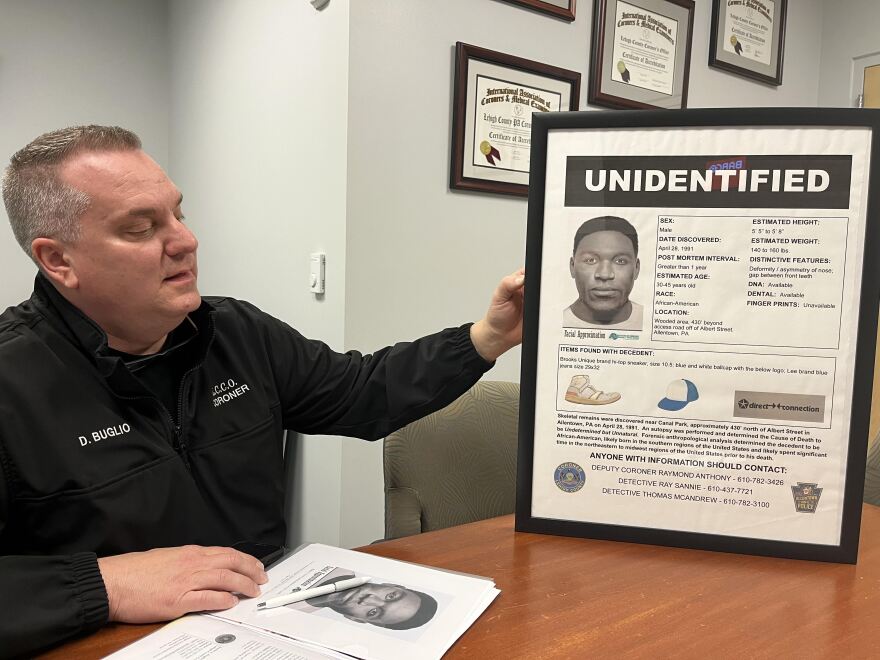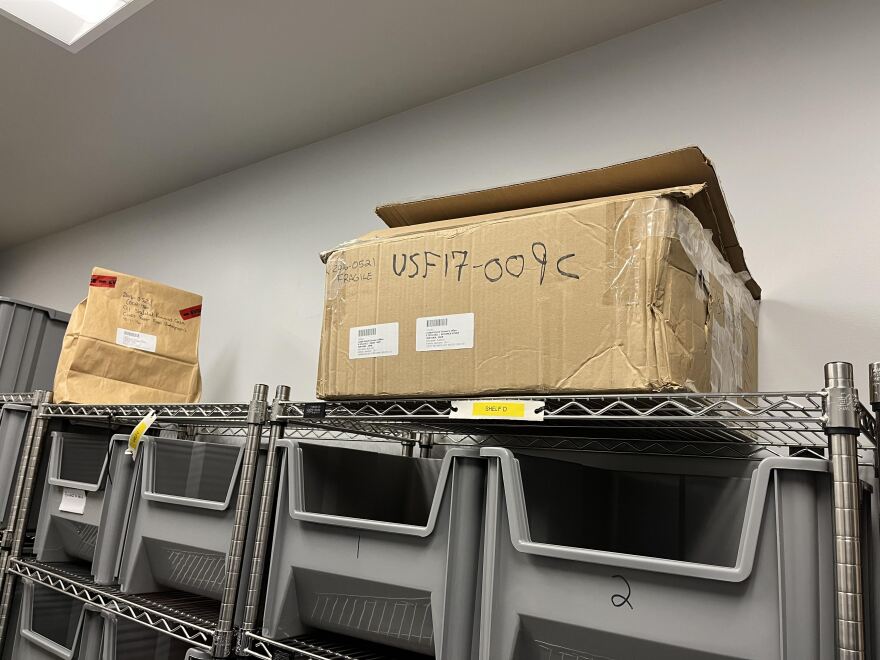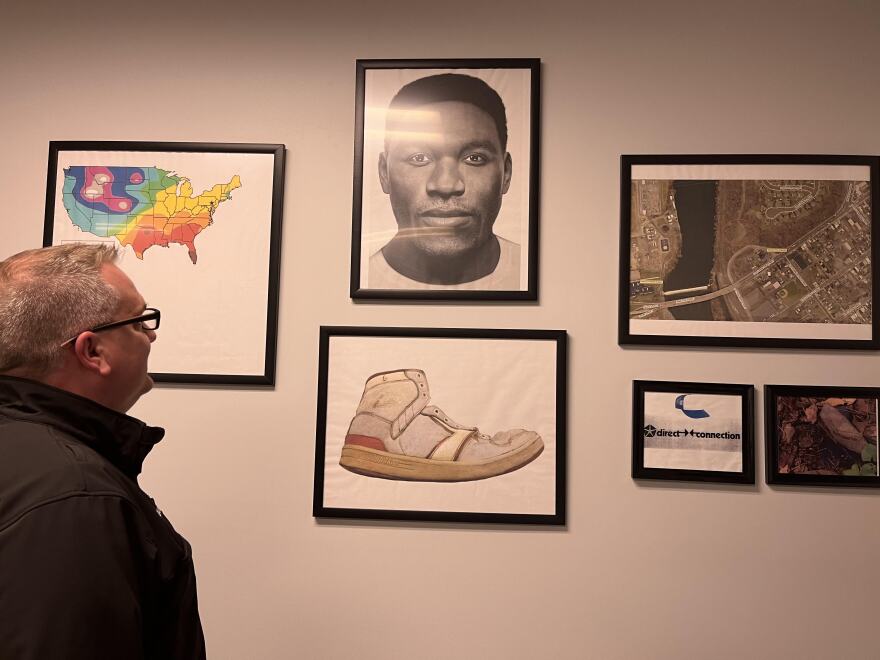ALLENTOWN, Pa. — The bones of the unidentified dead have much to say.
But to the dismay of Lehigh County Coroner Daniel A. Buglio, those pieces of a person in a weathered cardboard box on a high shelf of his office's evidence room have stopped talking.
At least for now.
- Lehigh County Coroner Daniel A. Buglio is working to determine the identity of skeletal remains discovered in Canal Park in Allentown in April 1991
- Forensic analysis has shown the remains to be an African-American male, aged 25-35 at time of death, who grew up in the South
- The unidentified case is the only one remaining in Lehigh County
It is Lehigh County's only remaining case of an unidentified body, and it's more than three decades old.
“He was somebody’s family member — a son, brother, husband — so we have to use every technology we have to find out who he is,” Buglio said recently at his office.
“We used all the technology available right now, but haven’t had any luck.”
Buglio fell silent. He stared for a moment at the informational poster that included a facial approximation of the mystery person who rested on the conference room table.
“It’s my duty to do everything I can to learn his identity,” he said. “He’s not just a box of bones. He belonged to someone.”

Sneakers with no laces
No one — not family, not friends, no one — has contacted any official authority anywhere in the country inquiring about the man's whereabouts, Buglio said.
For 32 years, the bones — a complete skeleton in pieces — have been packed away in resealable plastic bags in that cardboard box, labeled Case No. R 2016-0521.
R, for remains.
It’s my duty to do everything I can to learn his identity. He’s not just a box of bones. He belonged to someone.Daniel A. Buglio, Lehigh County coroner
He is unofficially known as John Doe, at least for now.
His skeletal remains were found by two hikers on a wooded hillside of Canal Park in Allentown on April 28, 1991.
Atop the skull was a blue-and-white baseball cap with the words Direct Connection preceded by the pentagram logo of Chrysler-Plymouth.
Lee brand jeans were on the skeleton, as were a pair of red-and-white Brooks Unique high-top sneakers, size 10 ½, no laces.
And nothing else. No wallet. No bicycle. No water bottle. No soda can. No candy wrapper. No drug paraphernalia.
Nothing there but a mystery.
“How might he have gotten there?” Buglio said. “There wasn’t Uber back then. No car nearby. Who goes hiking in sneakers with no laces?
“But most importantly, we have to find out who he is.”

Placed on a shelf
An autopsy performed the day after he was discovered determined the remains were of a male 25-35 years old.
The cause of death was listed as “undetermined but unnatural.”
“There was no trauma that would suggest foul play,” Buglio said. “Could he have had a heart attack? That’s a possibility. We just don’t know for sure what happened.”
In June 1991, the remains were sent to the U.S. Department of Defense Armed Forces Institute of Pathology, in Delaware, for anthropological analysis and a clay facial reconstruction.
But the case went unsolved and — figuratively and literally — was placed on a shelf.
In 2017, the coroner’s office tried to further the case by applying modern forensics not available in 1991. A grant was secured from the National Institute of Justice to provide funds for a forensic anthropologic analysis of the remains at the University of South Florida Anthropology Laboratory.
The results showed the man to have been of African-American descent, 5-feet-5 to 5-feet-8 inches tall, and weighing 140-160 pounds. It also showed the death likely occurred between Spring 1989 and Spring 1990.
The geochemical isotope analysis of dental and bone samples for chemical elements ingested through food and water showed the decedent was born in the United States, probably in South Florida or Central Texas.
Also, it showed he spent significant time prior to his death in the Midwest and Northeastern United States, possibly in the Allentown area.
A passion for solving problems
And that was that until Buglio earlier this year learned of a technology that matches DNA in a database that might assist in the search for the man’s identity.
“In February, we sent the mandible with six teeth in place, as well as additional loose teeth, to the Innovative Forensic Investigations in Emporia, Virginia,” Buglio said.
“We expect to get the results by August. Hopefully that will help us identify him. It could be another piece to the puzzle.”
He’d keep his garage open and I’d sneak in through there and into the embalming room. I was about 13. I’d sneak in. Saw dead people. I found it intriguing.Lehigh County Coroner Dan Buglio
Puzzles always interested Buglio growing up in Weatherly, Carbon County. Puzzles, science kits, Legos — problem solving was a passion.
He also lived a few doors away from a funeral home whose owner, Philip J. Jeffries, also was the county coroner.
“I was friends with his daughters and was always over there,” said Buglio, 49. “I’d watch as the bodies would come into the place.
"He’d keep his garage open and I’d sneak in through there and into the embalming room. I was about 13. I’d sneak in. Saw dead people. I found it intriguing. He’s the reason I’m a coroner.”
A passion for solving problems

As Buglio enters the coroner’s office every day, he said he looks up at the poster of John Doe hanging on a lobby wall.
He thinks of the unidentified man who for now rests in a weathered cardboard box on a high shelf in a narrow room.
"He’s somebody’s family. We have to find out who he is. We just don’t know.”Lehigh County Coroner Dan Buglio
“I’m a family man,” Buglio said. “I’ve taken care of families in the coroner’s office for 24 years. We don’t know who he is. But a relative has to be out there.
"He’s somebody’s family. We have to find out who he is. We just don’t know.”
A commitment to solving the mystery of someone who the coroner views as more than bones in a box. That is Buglio's identity.
No DNA testing required.


